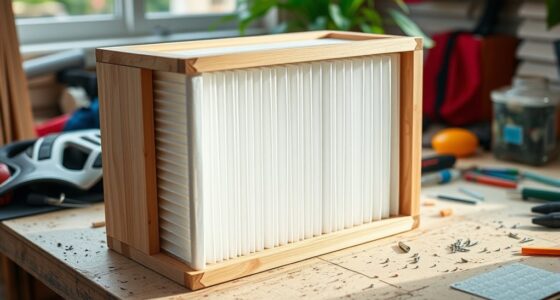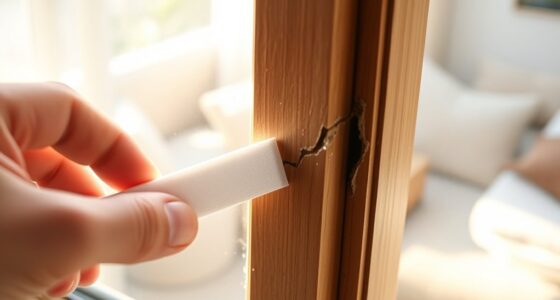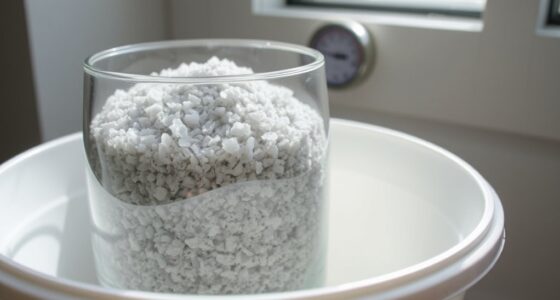To create a healthy nursery environment, focus on improving indoor air quality by using air purifiers with HEPA filters, adding non-toxic indoor plants like peace lilies, and ensuring good ventilation by opening windows when possible. Regular cleaning, avoiding smoking, and minimizing chemicals help reduce pollutants. Position air purifiers correctly for ideal effect, and choose child-safe plants. If you want practical tips to make your nursery safer and more comfortable, keep going to learn how to implement these strategies effectively.
Key Takeaways
- Use HEPA air purifiers placed centrally to efficiently remove dust, pet dander, and airborne pollutants.
- Incorporate child-safe indoor plants like snake plants or peace lilies to naturally filter toxins.
- Maintain good ventilation by opening windows regularly to ensure fresh air exchange.
- Avoid smoking, strong chemicals, and scented products to reduce indoor air pollution sources.
- Keep the nursery clean and dust-free to minimize allergens and promote a healthier environment.

Have you ever wondered how the air your children breathe affects their health? It’s a vital question because the quality of indoor air can profoundly impact their development, immunity, and overall well-being. In a nursery or kids’ room, you want to create an environment that minimizes pollutants and maximizes fresh, clean air. Luckily, there are practical steps you can take to guarantee your little ones are breathing safe.
One effective way to improve indoor air quality is by using air purifiers. These devices can filter out common airborne pollutants such as dust, pet dander, mold spores, and even some airborne bacteria or viruses. When choosing an air purifier for a nursery, look for models equipped with HEPA filters, as they are highly efficient at capturing small particles that could cause respiratory issues or allergies. Keep the purifier running continuously or at least during the hours your children are in the room to maintain a consistent level of clean air. Position it in a central location but away from walls or furniture that could obstruct airflow. By doing so, you actively reduce the presence of airborne pollutants that could trigger asthma or allergies, helping your children breathe easier and sleep better.
Using HEPA air purifiers helps reduce airborne pollutants and promotes healthier sleep for children.
In addition to air purifiers, indoor plants can naturally enhance the air quality of your child’s space. Certain houseplants, like snake plants, pothos, and peace lilies, are known for their ability to filter toxins such as formaldehyde, benzene, and trichloroethylene from the air. Not only do they improve air quality, but they also add a calming, natural element to the nursery environment. When selecting plants, make sure they are non-toxic and safe for children, as some common houseplants can be harmful if ingested. Keep the plants healthy and dust-free by wiping their leaves regularly. This simple addition can boost humidity levels, reduce airborne dust, and create a more soothing atmosphere for your kids, which can help them relax and sleep more soundly. Additionally, maintaining good indoor air quality is essential for supporting children’s immune systems and overall health. Creating a healthy nursery environment isn’t just about installing gadgets or adding plants; it’s about maintaining overall cleanliness and reducing sources of indoor pollution. Avoid smoking indoors, keep windows open when possible for ventilation, and minimize the use of strong cleaning chemicals or scented products that can release volatile organic compounds (VOCs). By combining these measures with air purifiers and indoor plants, you’re actively fostering a safe, fresh space where your children can thrive. Your efforts will pay off as you watch them grow healthier, happier, and more comfortable in an environment you’ve carefully designed for their well-being.
Frequently Asked Questions
How Can I Test Indoor Air Quality Effectively at Home?
To test indoor air quality effectively at home, you can use air quality sensors that monitor pollutants and humidity levels in real-time. DIY testing kits are also available; they typically include test strips or portable devices that measure specific contaminants like VOCs or mold spores. Regularly checking your home’s air quality helps you identify issues early and take steps to improve it, creating a healthier environment for everyone.
Are There Specific Plants That Improve Nursery Air Quality?
You ask if specific plants can improve nursery air quality. Yes, air purifying plants like snake plants, pothos, and peace lilies are excellent choices. They naturally filter toxins and add nursery greenery, creating a healthier environment. Just make sure to select non-toxic varieties safe for children, and keep plants well-maintained to maximize their air-cleaning benefits. Incorporating these plants helps ensure a clean, safe space for your little one.
How Often Should Nursery Air Filters Be Replaced?
You should replace nursery air filters based on your filter replacement and maintenance schedule, typically every 1 to 3 months. Regular maintenance is key to ensuring ideal air quality. Check your filters monthly for dirt and buildup, and follow the manufacturer’s recommendations. Keeping up with timely filter replacement helps maintain a healthy environment for children, reducing allergens and pollutants effectively.
Can Certain Paints or Furniture Affect Indoor Air Quality?
Certain paints and furniture can impact indoor air quality by releasing VOC emissions, which may cause health issues. To reduce this, choose items with non-toxic finishes that emit fewer volatile organic compounds. When selecting paint or furniture, look for those labeled low or zero VOC, ensuring a healthier environment. This proactive step helps maintain good air quality and creates a safer space for everyone, especially children.
What Signs Indicate Poor Air Quality Affecting My Child’s Health?
When you’re trying to recognize symptoms of poor air quality, pay attention to signs like coughing, sneezing, or itchy eyes in your child. Environmental triggers such as strong odors, dust, or mold can worsen these symptoms. If your child experiences frequent respiratory issues or allergies, it’s a clear sign to check your home’s air quality. Regular ventilation and reducing indoor pollutants can help create a healthier environment for your little one.
Conclusion
Creating a healthy nursery environment is like planting seeds for a brighter future. By paying attention to air quality, you’re not just providing fresh air—you’re nurturing your child’s growth and well-being. Every small step you take acts as a shield against unseen dangers, turning your home into a safe haven. Remember, a clean, breathable space is the foundation upon which your little one can soar, blossom, and thrive. Your efforts today shape their tomorrow.









